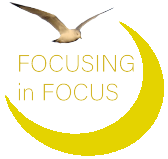
BIOSPRITUAL FOCUSING:
A Gift to the Whole Body
Nada Lou
In the communist country where I was born, religion of any kind was forbidden. In my adopted country, Canada, my interest was to discover the truth beyond organized religion: that is, I wanted to find out what Jesus actually said. I wanted to search the original source as closely as possible in order to discover what was added through the centuries. This search motivated me to study Christian theology at Loyola University in Montreal. While studying at the university, I searched through historic and academic documents to better understand who was Jesus of history and who was Jesus of faith.
As part of my studies and personal interests, I joined a group practicing the Spiritual Exercises of St. Ignatius of Loyola at a local Spiritual Centre. Ignatian Exercises are based on the writings of St. Ignatius of Loyola, the founder of the Jesuit order (1491-1556.) The Exercises consist of prayers, meditations, readings and a certain order of rules to follow. A Spiritual Director serves as a listener and guide in this process. When I started to do the Ignatian Exercises, I began to practice applying some of the academic concepts I was learning to my way of living.
While involved in these activities, I happened to discover a small book, Focusing, by Eugene Gendlin, on the bookshelf at the Centre. What I read in that book deeply resonated with the Exercises that I was doing. Ignatius recommends that people experience their reading and prayers with “all the senses.” That is, to literally see, hear, smell, touch, and taste the goodness of God in their contemplations. Ignatius’ thinking, vision and temperament were always very attractive to me in the sense of his life direction as “contemplative in action.” Having a Spiritual Director, Lisbeth, who listened to what came through my prayers, was a real bonus to me in many ways. Lisbeth also knew BioSpiritual Focusing and offered me my first taste of Focusing. After being listened to in a Focusing way, I got hooked on it for life.
Soon after, I discovered BioSpiritual Focusing workshops given by Fathers Ed McMahon and Peter Campbell. Originally trained in the spiritual tradition of the Jesuits, Campbell and McMahon explored the link between Focusing and Spirituality. They created the Institute for BioSpiritual Research and attracted a large following to their way of Focusing as a spiritual practice.
In their research they came to the conclusion that being able to experience meaning through the bodily felt sense is the bridge into Jesus’ original message and “larger body” that some of us call God. My search for deeper faith had received another nod! I began to follow and videotape their workshops around North America. These experiences launched me into developing my new hobby—videotaping, editing, and producing their message.
A quote from the BioSpiritual Focusing webpage still resonates for me:
“It is the human body which provides our most grounded spiritual link, both to the details of daily living as well as the mystery of an evolving universe. Paradoxically, our body, which we so identify with mortality and decay, is itself our conscious bridge into immortality! It is our precious “link” to the universe as a whole …and beyond!”
In my own story, the first thing I discovered in BioSpiritual Focusing was a totally different approach to prayer, Focusing alone. As a part of Ignatian exercises and prayer, in my imagination I would sit on the log by the ocean—my favorite place to be—”talking to Jesus” as if he were my listener. It felt as though whenever I would ask Jesus a question, he would respond, “And what do YOU think”? Gradually I realized that what “I” think has value—enough value to be heard without judgment. That realization changed my prayer of “petition” into prayer of personal discovery. It began also to be a change of thinking about God only from the neck up. The felt sense in my body became the bridge into the bigger Body—the source of all life and all love.
When I hold whatever “issue” I might have, just as it is—as bad as it might seem to be—I acknowledge the truth of myself. When I am willing to hold it gently just as it is, and let it breathe on its own, something comes that changes it. During this time of being with my truth as it is, as I feel it in my body, not fixing it, nor running away from it or shutting it off, I am creating a “Space for Grace.” To me, this term, originated by McMahon and Campbell, means that I am holding the issue with a benevolent attitude and being in an actively passive relationship with it. By doing this, I am inviting and allowing something to come in this space that brings a new information and energy. When this happens, I know I did not bring the change by something that I have done. Further, the change has an element of surprise in it; my physical felt sense shifts, which also brings me the experience of the change as being a gift. Gendlin’s terms for this kind of process are “holding and letting.” Gendlin says that both of these must be present for shifts to occur.
As I developed this practice of integrating the Spiritual Exercises of St. Ignatius and BioSpiritual Focusing, I noticed that something significant happens. First, I become aware of a sense that I am somehow not alone in the process. I start feeling a change in how my body carries the issue. Then I notice something that seems like it was always there, but was not on my radar before. Initially this something is not clear, and yet I find myself in a different relationship with something more far-reaching than me. What comes is new information and new energy. In spiritual language, information is referred to as revelation, and new energy is called Grace. What this means is that what comes to me in Focusing is something that I didn’t make up or invent—it simply comes to me as if it were always there but unnoticed. The information surprises me and also makes the next step clear.
Recognizing that the shift is a gift is a significant contribution to the understanding of the Focusing process that McMahon and Campbell illuminated in BioSpiritual Focusing.
Felt sensing experiencing in Bio-Spiritual Focusing carries an additional implication. For those who have an interest in and awareness of a spiritual dimension in life, the felt sense is experienced as a bridge, connection, catalyst or “…” to a Higher Power. Once connected, there is an awareness of a sense of being a living cell that is a part of a larger existence: I become both a part of and participant in the living process. McMahon and Campbell explain this is what is meant by “The Body of Christ” in Christian theology.
I began to teach BioSpirituality to others.
McMahon and Campbell used to say Gendlin this and Gendlin that…with great admiration for “the great man.” Finally I said to myself, “…let me go to the horse’s mouth.” What I discovered, of course, was both a lot more and different.
I came to understand that Gendlin’s theory of Focusing has led to many different approaches of bringing Focusing into people’s lives. BioSpiritual Focusing is an example of one of these approaches. Research done by McMahon and Campbell has taken a direction that has fully incorporated Gendlin’s practice of Focusing, and has gone a step further to illuminate and include the spirituality of the body. This concept is in contrast to many religious practices in which the body has not only been excluded, but has been condemned as a source of evil.
First videotaping and then editing, learning, teaching and co-teaching, and collaborating with Gendlin, I discovered that my “crossing” with BioSpirituality happened even before I found Gendlin’s book and the Focusing Institute community.
As a result of my own crossing I am able to describe some specific highlights that I see as additional refinements of Focusing by the BioSpirituality approach:
POTENTIAL FOR GLOBAL SPIRITUALITY
Although McMahon and Campbell’s terminology comes from their Catholic background, it quickly becomes possible to recognize that the ability to bodily (felt sensingly) connect to a God beyond all names does not require a specific religious affiliation. Felt sensing provides “body” to “BODY” connections from which life forward direction comes as a gift. In other words, through this practice, we are able to connect the personal “body” to the larger Divine BODY. The use of the word “global” indicates that this practice is applicable to all religions. One thing we all have in common is the body. Experiencing one’s own human body in a felt sensing way provides the common ground for a global spirituality.
CARING FEELING PRESENCE AND THE FOCUSING ATTITUDE
McMahon and Campbell developed a very specific way of attending to what is “between me and feeling all O.K.”—that quality of attending which is often referred to in Focusing as the Focusing Attitude. Their signature name for this attitude is “Caring Feeling Presence.” Experiencing in a bodily way how it would be to attend to an abandoned baby or a hurt animal, and conveying an unspoken felt message to it that its life is valuable and important—is at the core of employing Caring Feeling Presence. Learning to hold this kind of caring message makes it possible for this attitude to be applied to one’s own abandoned and hurt issues.
DWELLING AND THE ART OF WAITING
Being patient in not-yet-shifted (answered) situations is often challenging even for those who know Focusing but intellectually want the answer “NOW”. Gendlin calls this difficult waiting aspect of the process “holding and letting.” He counsels that a shift “comes” in its own time and quality. It can not be demanded or forced in any way. This attitude of “holding and letting” receives special significance in BioSpiritual Focusing because the shift is seen as a gift, and thus it cannot be manipulated. Understanding that the magnitude and timing of this gifting includes an attitude of caring benevolence, underlines the loving relationship between the “giver” and receiver.
RECEIVING THE GIFT
The last step in a Focusing process has been enriched in BioSpiritual Focusing. It consists of 3 movements:
- The first is reviewing the process’s path. Looking back at the step-by-step movement often brings more insight into what has already come.
- Second is taking the time to receive the shift—the gift—in a quiet, meditative way. It is essential to recognize that such gifts affect one’s whole life, self-identity and selfperception. Such gifts change us and also affect our next steps in life.
- Third is taking some time to thank our own body for what we received and to be grateful for its being the receptor that gives us the sense of being part and participant of creation.
One of the newest movements coming from BioSpirituality is realization that once we know how to be in touch with the felt sense, we can connect with it at any moment in time. “Noticing and Nurturing” is a habit that requires our awareness—so that paying inner attention becomes a way of life—rather than another thing ‘to do’. This habit ‘crosses’ with other Focusing orientations in what we often refer to as the PAUSE.
My personal and specific crossings are also supported through the many different video tapes and DVD’s that I’ve made portraying Gendlin, and McMahon & Campbell—in addition to over 20 DVD’s of various Focusing teachers around the world, who have profoundly contributed to the richness of what I know about crossings. These productions are not only DVD’s—they represent my special creative felt sensing of crossing Focusing with so many other methods.
You may learn more about Bio-Spiritual Focusing at www.biospiritual.org
Nada Lou is a TFI Coordinator, Focusing and TAE teacher and Focusing DVD producer. She lives in Montreal Canada
